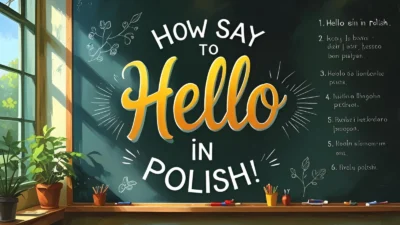Learning how to say hi in Thai is a great way to connect with locals and show respect for their culture. Thai greetings change depending on the level of formality and the gender of the speaker.
The most common phrase is sawasdee (สวัสดี), which can be used in both casual and polite situations, usually followed by a polite particle like ka (ค่ะ) for women or krub (ครับ) for men. Mastering these greetings will help you start conversations naturally and make a positive impression in Thailand.
Say Hi in Thai
Here are 15 ways to say hi in Thai, each explained with a real conversation and a bit of background so you can sound authentic and confident.
🌸 15 Ways: How to Say Hi in Thai
| # | 🟦 Thai Phrase (ภาษาไทย) | 🟩 Romanization | 🟨 English Meaning | 🟧 Usage |
|---|---|---|---|---|
| 1 | สวัสดีครับ | Sawasdee krub | Hello/Hi (male speaker) | Polite & standard |
| 2 | สวัสดีค่ะ | Sawasdee ka | Hello/Hi (female speaker) | Polite & standard |
| 3 | หวัดดี | Wad dee | Hi / Hello | Informal |
| 4 | หวัดดีครับ | Wad dee krub | Hi (male, casual polite) | Semi-formal |
| 5 | หวัดดีค่ะ | Wad dee ka | Hi (female, casual polite) | Semi-formal |
| 6 | สวัสดีตอนเช้า | Sawasdee ton chao | Good morning | Polite greeting |
| 7 | สวัสดีตอนบ่าย | Sawasdee ton bai | Good afternoon | Polite greeting |
| 8 | สวัสดีตอนเย็น | Sawasdee ton yen | Good evening | Polite greeting |
| 9 | ไปไหนมา | Pai nai ma? | Where have you been? (hi) | Informal |
| 10 | สบายดีไหม | Sabai dee mai? | How are you? (hello) | Friendly greeting |
| 11 | สวัสดีจ้า | Sawasdee ja | Hi (friendly, female) | Warm/casual |
| 12 | หวัดดีจ้า | Wad dee ja | Hi (friendly, informal) | Very casual |
| 13 | ฮัลโหล | Hal-loh | Hello (phone call) | Informal/phone |
| 14 | เฮ้ | Hey | Hey / Hi | Very informal |
| 15 | ดีครับ/ดีค่ะ | Dee krub / Dee ka | Hi / What’s up | Casual modern |
1. สวัสดี (Sawasdee)
Origin:
This is the standard Thai greeting, created in the 1930s as part of a national campaign to unify and modernize the Thai language.
Example:
👤 User A: สวัสดีครับ (Sawasdee khráp)
👤 User B: สวัสดีค่ะ (Sawasdee khâ)
Use: Universal; polite and respectful. Add “khráp” (male) or “khâ” (female) at the end.
2. หวัดดี (Wàt-dee)

Origin:
This is a casual, shortened form of sawasdee, mostly used among friends or young people.
Example:
👤 User A: หวัดดี! ไปไหนมา?
👤 User B: ไปตลาดมา
Use: Informal; relaxed and friendly.
3. ว่าไง (Wâa ngai?) – What’s up?
Origin:
Colloquial Thai; equivalent to “What’s up?” in English.
Example:
👤 User A: ว่าไงเพื่อน?
👤 User B: ก็เรื่อยๆ นายล่ะ?
Use: Very casual, mostly among close friends.
4. เป็นยังไงบ้าง (Bpen yang-ngai bâang?) – How’s it going?

Origin:
Common in daily conversation, often used when checking in on someone.
Example:
👤 User A: เป็นยังไงบ้าง?
👤 User B: สบายดี ขอบคุณ!
Use: Friendly and casual.
5. โย่ว (Yôh) – Yo!
Origin:
Borrowed from English “Yo”, used in Thai pop and youth culture.
Example:
👤 User A: โย่ว! นายหายไปไหนมา?
👤 User B: ไปเที่ยวกับครอบครัวมา
Use: Trendy, very informal.
6. เฮ้ (Héy) – Hey!

Origin:
Thai adaptation of the English “Hey”, widely used in online or youth slang.
Example:
👤 User A: เฮ้! พร้อมยัง?
👤 User B: พร้อมแล้ว ไปเลย!
Use: Friendly and relaxed; used by teens and young adults.
7. สวัสดีตอนเช้า (Sawasdee dton cháo) – Good morning
Origin:
“ตอนเช้า” means “morning.” It’s a polite way to greet someone early in the day.
Example:
👤 User A: สวัสดีตอนเช้าครับคุณครู
👤 User B: สวัสดีจ้ะ มาเช้าเลยนะวันนี้
Use: Formal or polite morning greeting.
8. สวัสดีตอนบ่าย (Sawasdee dton bàai) – Good afternoon
Origin:
Used in formal settings to greet during the afternoon hours.
👤 User A: สวัสดีตอนบ่ายครับ
👤 User B: สวัสดีค่ะ ยินดีที่ได้พบกันอีก
Use: Polite afternoon greeting.
9. สวัสดีตอนเย็น (Sawasdee dton yen) – Good evening
Origin:
Evening variation of the standard “sawasdee”.
Example:
👤 User A: สวัสดีตอนเย็นค่ะ
👤 User B: สวัสดีครับ ขอให้มีความสุขคืนนี้นะ
Use: Polite and respectful evening greeting.
10. ดีจ้า (Dee jâa)

Origin:
Cute, casual version used by females in casual chats or texting.
Example:
👤 User A: ดีจ้า ไปเที่ยวมาเหรอ?
👤 User B: ใช่ สนุกมากเลย!
Use: Very casual, sweet, and feminine.
11. ดีครับ (Dee khráp)
Origin:
Casual, shortened form of “sawasdee,” commonly used by males in friendly chats.
Example:
👤 User A: ดีครับ สบายดีไหม?
👤 User B: ดีมากเลย ขอบคุณนะ
Use: Casual male-friendly greeting.
12. หวัดดีจ้า (Wàt-dee jâa)
Origin:
A cute variation combining casual and feminine tones.
Example:
👤 User A: หวัดดีจ้า! วันนี้แต่งตัวน่ารักมาก
👤 User B: ขอบใจน้า~
Use: Friendly and informal; often used in texting.
13. โอ๊ย หวัดดี! (Oói, wàt-dee!) – Oh hi!
Origin:
Used to show surprise or joy upon unexpectedly seeing someone.
Example:
👤 User A: โอ๊ย หวัดดี! ไม่เจอตั้งนาน
👤 User B: จริงด้วย คิดถึงมากเลย
Use: Expressive and casual; shows excitement.
14. ไงบ้าง (Ngai bâang?) – What’s up?
Origin:
A reduced and snappy version of “เป็นยังไงบ้าง?”
Example:
👤 User A: ไงบ้าง? นานเลยนะ
👤 User B: ใช่ งานยุ่งมากเลย
Use: Very casual; used with close friends.
15. เฮลโหล (Hello – transliterated)
Origin:
A phonetic borrowing of the English “Hello,” often used on the phone.
Example:
👤 User A: เฮลโหล~ ใครอ่ะ?
👤 User B: เราเองไง จำไม่ได้เหรอ?
Use: Casual, often playful; used mostly in speech and texting.
FAQs
- What is the common way to say hi in Thai?
The most common word is “Sawasdee” (สวัสดี). - How do you pronounce “Sawasdee”?
It’s pronounced sa-wat-dee. - Do people say it differently?
Yes. Men say “Sawasdee krub” (สวัสดีครับ), and women say “Sawasdee ka” (สวัสดีค่ะ). - Is “Sawasdee” formal or informal?
It’s polite and can be used in both formal and casual situations. - Can I use “Sawasdee” for hello and goodbye?
Yes! It works for both hello and goodbye in Thai. - How do Thai people greet each other?
They say “Sawasdee” and do a small bow with hands pressed together (called a wai). - Do Thai people use casual greetings like “Hi”?
Yes, younger people sometimes say “Hi” or “Hello” in English too. - When should I use “krub” or “ka”?
Men use krub, and women use ka to sound polite. - Is “Sawasdee” used in all parts of Thailand?
Yes, it’s understood and used everywhere in Thailand. - How do you respond when someone says “Sawasdee”?
You reply with the same word — “Sawasdee krub” or “Sawasdee ka.”
Conclusion:
In Thai, saying hi is about more than just speaking the words — it’s about showing kindness and cultural respect. Whether you’re going formal with “sawasdee”, or casual with “wàt-dee” or “yo”, these 15 greetings will help you connect more authentically in Thai conversations.



